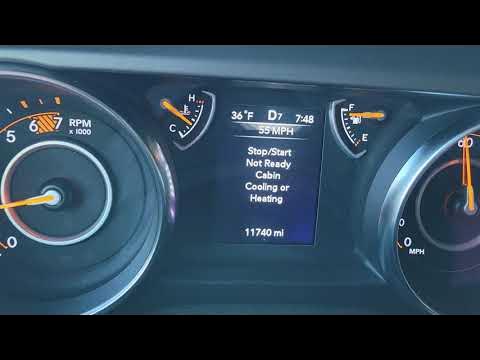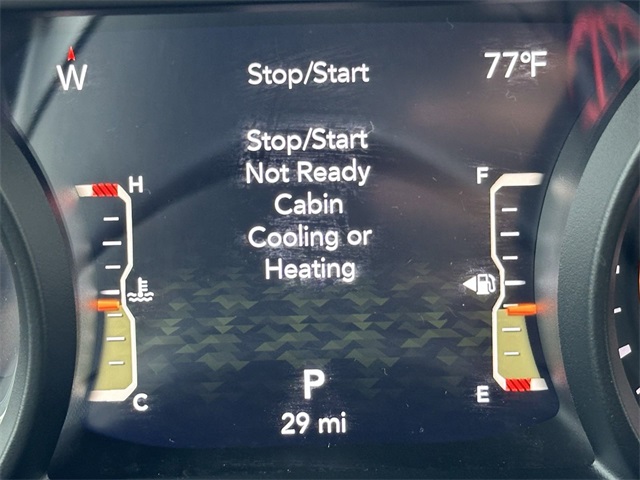Stop/Start Not Ready Cabin Cooling or Heating means your vehicle’s engine auto-stop feature is disabled to maintain cabin comfort. This ensures consistent temperature control inside your car.
Many modern vehicles come with a Stop/Start system designed to save fuel by automatically shutting off the engine when the car is idle. However, this system can be temporarily disabled if the cabin cooling or heating needs to be maintained.
This feature is crucial for keeping the interior climate comfortable, especially during extreme weather conditions. Stop/Start Not Ready alerts drivers that the system is not active to prioritize passenger comfort. Understanding this feature helps drivers better manage their vehicle’s fuel efficiency while ensuring a pleasant driving experience.

Common Issues
The Stop/Start system is designed to improve fuel efficiency by shutting down the engine when the vehicle is stopped. However, it can encounter issues that affect cabin cooling or heating. Let’s explore some common issues that can arise with this system.
System Not Starting
One common issue is the system not starting when expected. This can be due to several reasons:
- Battery Voltage: A low battery can prevent the system from starting. The system needs sufficient power to function properly.
- Engine Temperature: If the engine is too cold or too hot, the system may not activate. It needs the engine to be within a certain temperature range.
- Climate Control Settings: If the climate control is set to a high demand, the system may not start. It prioritizes maintaining a comfortable cabin temperature.
System Not Stopping
Another issue is the system not stopping the engine when it should. This can happen for various reasons:
- Battery Charge Level: If the battery is not sufficiently charged, the system will keep the engine running. It ensures the battery can handle the next start.
- Cabin Temperature: If the cabin temperature deviates too much from the set point, the system may keep the engine running. It maintains comfort for passengers.
- Brake Pressure: Inadequate brake pressure can prevent the system from stopping the engine. It needs proper brake pressure to ensure safety.
Understanding these common issues can help in troubleshooting and ensuring the system works efficiently. Always check these factors if you face problems with the Stop/Start system.
Basic Troubleshooting
Experiencing issues with your car’s Stop/Start system, especially with cabin cooling or heating, can be frustrating. Fortunately, basic troubleshooting can often resolve these problems. We’ll explore two key steps: checking the power supply and inspecting thermostat settings.
Check Power Supply
First, ensure that your vehicle’s power supply is intact. A weak battery can disrupt the Stop/Start system. Use a voltmeter to measure the battery voltage. It should read around 12.6 volts when the car is off. If it’s below 12 volts, consider charging or replacing the battery. Also, inspect the battery terminals for corrosion. Clean them with a mixture of baking soda and water if needed.
| Power Supply Check | Action |
|---|---|
| Battery Voltage | 12.6 volts |
| Corrosion Check | Clean terminals |
Inspect Thermostat Settings
Incorrect thermostat settings can affect cabin temperature. Ensure the thermostat is set to your desired temperature. For cooling, set it lower; for heating, set it higher. Check the mode settings as well. The system should be set to either cooling or heating mode, not just ventilation.
Use the climate control panel to adjust settings. If the settings are correct and the problem persists, there might be an issue with the thermostat itself. Consider consulting a professional for further diagnostics.
- Check thermostat temperature settings
- Ensure correct mode (cooling/heating)
- Consult a professional if issues persist
Advanced Diagnostics
The Advanced Diagnostics for your vehicle’s stop/start system ensures optimal cabin comfort. Diagnosing issues with cabin cooling or heating during stop/start events requires attention to detail. This section will guide you through inspecting electrical connections and evaluating sensor performance.
Inspect Electrical Connections
Start by checking all electrical connections. Loose or corroded connections can lead to malfunctioning systems. Use a multimeter to test for continuity. Ensure all connectors are tight and free from corrosion.
| Component | Check |
|---|---|
| Battery Terminals | Ensure tight and corrosion-free |
| Wiring Harness | Inspect for wear and tear |
| Fuses | Check for blown fuses |
- Disconnect the battery before inspecting connections.
- Use dielectric grease to prevent corrosion.
- Secure any loose wires properly.
Evaluate Sensor Performance
Sensors play a crucial role in the stop/start system. Faulty sensors can disrupt cabin cooling or heating. Use an OBD-II scanner to check for sensor faults. Pay close attention to temperature sensors.
- Connect the OBD-II scanner to the vehicle’s port.
- Read error codes related to the HVAC system.
- Replace any faulty sensors identified.
Ensure sensors are clean and free from debris. Dirt can affect sensor readings. Regular maintenance helps maintain sensor accuracy.
By following these steps, you can maintain a comfortable cabin environment. Proper diagnostics ensure your stop/start system performs efficiently.
Quick Fixes
Experiencing issues with your car’s stop/start system affecting cabin cooling or heating? These quick fixes can help. Resetting the system and cleaning air filters often solve the problem.
Resetting The System
Resetting your car’s system is simple. First, turn off the car completely. Wait for about 30 seconds. Restart the engine. This reset often clears minor software glitches.
Follow these steps:
- Turn off the car.
- Wait for 30 seconds.
- Restart the engine.
This method helps reset the stop/start system. It can restore cabin cooling or heating functions.
Cleaning Air Filters
Dirty air filters can disrupt cabin climate control. Cleaning them is crucial.
Here’s how to clean air filters:
- Locate the air filter compartment.
- Remove the filter.
- Inspect for dirt and debris.
- Clean or replace if necessary.
Regularly cleaning air filters ensures optimal cabin cooling or heating. Clean filters improve air quality and system efficiency.
| Step | Action |
|---|---|
| 1 | Turn off the car. |
| 2 | Wait for 30 seconds. |
| 3 | Restart the engine. |
| 4 | Locate air filter compartment. |
| 5 | Remove and inspect the filter. |
| 6 | Clean or replace the filter. |
Follow these quick fixes to resolve stop/start system issues. Keep your car’s cabin comfortable in all conditions.
Preventive Maintenance
Preventive maintenance keeps your car’s Stop/Start system in top shape. This system helps save fuel and reduce emissions. Ensuring it works well means your cabin cooling or heating won’t face issues.
Regular Inspections
Regular inspections can catch small problems early. These checks should include:
- Battery condition
- Alternator performance
- Starter motor health
- Cooling and heating system checks
A mechanic should perform these inspections. They have the tools and knowledge to find hidden issues.
Scheduled Servicing
Scheduled servicing is crucial for the Stop/Start system. Follow the service intervals in your car’s manual. Key areas to focus on during servicing are:
- Battery replacement if needed
- Software updates
- Checking all electrical connections
- Ensuring proper refrigerant levels in the A/C system
These steps ensure your car’s Stop/Start system works seamlessly with the heating and cooling systems.
| Maintenance Task | Frequency |
|---|---|
| Battery Check | Every 6 months |
| Software Update | Annually |
| Cooling/Heating System Check | Every 6 months |
| Electrical Connection Check | Every 6 months |
Keeping to this schedule helps avoid Stop/Start Not Ready issues. It ensures your cabin stays comfortable, no matter the season.

Expert Help
When your vehicle’s cabin cooling or heating system isn’t working, it’s frustrating. Sometimes, the issue might be simple. Other times, you need expert help. Knowing when to call a professional can save time and stress. Let’s explore when and how to choose the right technician for your car.
When To Call A Professional
It’s important to identify when you need professional help. Here are signs to watch for:
- Strange noises coming from the cooling or heating system.
- Unusual smells when the system is running.
- System not responding to controls.
- Frequent cycling on and off without proper temperature control.
These issues often need a professional’s touch. They have the tools and experience to fix complex problems.
Choosing The Right Technician
Picking the right technician is crucial. Here’s what to consider:
- Certification: Ensure the technician is certified. Look for credentials like ASE.
- Experience: Check their experience with your car’s make and model.
- Reviews: Read customer reviews. Look for positive feedback and satisfied clients.
- Warranty: Check if they offer a warranty on parts and labor.
Choosing a qualified technician ensures your car’s system is in good hands.
Frequently Asked Questions
Why Is My Auto Start-stop Not Working In Hot Weather?
High temperatures can cause the auto start-stop system to deactivate. The system prioritizes cooling the engine and cabin. This ensures optimal performance and comfort.
What Does It Mean When It Says Start-stop Not Ready?
“Start-stop not ready” means the vehicle’s start-stop system isn’t active. This can happen due to low battery, engine temperature, or other factors.
Does Stop Start Not Work In Cold Weather?
Stop-start systems often don’t work well in cold weather. The engine needs to maintain warmth for optimal performance.
Why Is My Auto Start-stop Not Working?
Your auto start-stop might not work due to low battery charge, extreme temperatures, or a malfunctioning sensor. Ensure all doors and seat belts are secured. Consult your vehicle’s manual for specific requirements.
Conclusion
Optimize your cabin comfort with proper stop/start readiness for heating or cooling. Regular maintenance ensures efficient performance. Address issues promptly to avoid inconvenience. Enjoy a pleasant driving experience by keeping your system in top shape. Prioritize vehicle health for consistent cabin comfort throughout the year.

